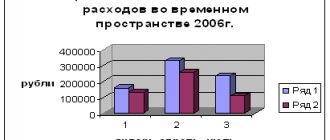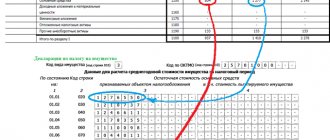Features of profit distribution
It is fundamentally important to distribute profits correctly. This must be done in such a way that the efficiency of the enterprise increases, not decreases. Let's consider the basic principles of fund distribution:
- The company's profit is directed to the needs of the enterprise, and is also paid to the state budget. That is, taxes are paid on this money.
- Profit tax is paid at a rate set by law. She can't change.
- Most of the profits should be directed to the enterprise budget for accumulation. The rest goes to various company expenses.
- Proposed expenses must be agreed upon by the majority of LLC participants.
What accounting data is used when filling out line 1370 “Retained earnings (uncovered loss) ” when preparing annual reporting?
The enterprise must pay taxes and various contributions, after which the state cannot interfere in decisions on the distribution of money.
What can retained earnings from previous years ?
Let's look at which funds the money goes to:
- Savings fund . This fund accumulates funds to ensure the stable operation of the company and its independence from creditors. If a company has free funds of its own, it is not subject to bankruptcy. For example, if a company received very little income in one month and therefore cannot pay its existing debt, funds to pay off the debt are taken from the fund. It also finances research work, issue of shares, personnel training, and purchases new property.
- Consumption Fund . Funds from this fund go to social needs. For example, this could be payment of bonuses, financing of travel packages, purchase of medicines for employees, and various allowances.
- Reserve fund . Reserves are needed to reduce the risks of an enterprise when conducting various transactions. They will be needed in case of unforeseen situations. That is, if the company makes a small profit in one period, expenses can be covered from the reserve fund.
Part of the funds, as a rule, remains undistributed. This money is directed to the authorized capital of the company.
Specific areas of spending
There are two areas where net profit goes:
- Accumulation of enterprise reserves. Increasing the volume of property.
- Consumption. Spending money on specific needs.
Let's look at examples of spending net profit:
- Purchase of new equipment.
- Repair of existing equipment.
- Increasing the working capital of the enterprise, which is “eaten up” by inflation.
- Payment of loans and debts. Payment of interest on debt.
- Measures aimed at protecting the environment from pollution.
- Payment of bonuses.
- Organization of charity events.
- Calculation of motivating bonuses to employees.
- Payment of debts to creditors and banks.
- Payment of taxes.
- Payment of various sanctions.
- Retraining of employees.
Almost all of these expenses are optional. Spending occurs at the will of the enterprise management. First, the money is directed to priority purposes. For example, a company has only obsolete equipment. Therefore, first of all, funds should be allocated to updating equipment.
Disproportional distribution of profits between LLC participants
Dear Colleagues,
as is known Art. 28 of the Federal Law on LLC provides that part of the company’s profit intended for distribution among its participants is distributed in proportion to their shares in the authorized capital of the company. The charter of the company upon its establishment or by introducing amendments to the charter of the company by decision of the general meeting of the company's participants, adopted unanimously by all the company's participants, may establish a different procedure for the distribution of profit between the company's participants. Amendments and exclusions of the provisions of the company's charter establishing such a procedure are carried out by decision of the general meeting of the company's participants, adopted unanimously by all the company's participants.
Accordingly, the imperative norm establishes that the procedure for distributing profits between participants disproportionate to the size of their share in the authorized capital of the company can be determined exclusively at the level of the charter by adopting such a provision of a local regulatory act unanimously.
Thus, the corporate agreement cannot contain the provisions that interest us on the disproportionate distribution of profits. Can such judgments apply to a unanimous corporate agreement? It seems that the answer should be positive due to the same imperative nature of the requirements of Art. 28 Federal Law on LLC. What is noteworthy in this case is the case involving Verniy Znak LLC.
I also believe that the charter cannot contain blanket (referential) provisions on the possibility of determining the disproportionate distribution of profits within the framework of a corporate agreement. For example, the charter stipulates that profits between participants are subject to disproportionate distribution, and exactly how (specific figures and reasons for such distribution) is specified in the corporate agreement.
The reasons are as follows: firstly, not everyone can enter into a corporate agreement (the matter, as they say, is voluntary, freedom of contract). Secondly, the participants of an LLC can change and the provisions of such a corporate agreement do not automatically apply to new arrivals.
Thus, any manipulations with the proportionality prescribed by law in terms of profit distribution are possible only at the level of the charter. The essence of this imperative rule, in my opinion, is the need to maintain a balance of interests of LLC participants; it is for this reason that the law also imperatively enshrines unanimity regarding the adoption of a decision at a general meeting of company participants to change the procedure for distributing profits.
In the charter, in order to establish a disproportionate distribution of profits, it can be stated that a participant owning a 51% share is entitled to 90% of the distributed profit of the company, and a participant owning 49% is entitled to 10% of the distributed profit. This provision may not contain the motives for the proposed mechanism for departing from the proportion.
I am wondering whether it is necessary to duplicate and determine the “validity period” of the mechanism for indentation from the proportion in the corporate agreement? By “validity period” I mean, for example, provisions in a corporate agreement establishing the conditions and procedure for voting by participants on amendments to the charter, repealing the rules on disproportionate distribution of profits, as well as liability if a participant votes differently.
Colleagues, how did you resolve the issue of disproportionate distribution of profits between LLC participants? What other mechanisms are applicable? What thoughts do my research evoke in you?
Accounting for distributed profits
Spending on taxes is deducted from the profit received. The tax base is determined based on the information set out in line 1 “Calculation of tax on real profit”. When deducting tax, the following entries will be used:
- Debit account 99 – the amount of profit is recorded.
- Credit to account 68 “Tax calculations”.
The company may receive extraordinary profits. For example, they appear when insurance companies pay compensation. In this case, the following wiring applies:
- Credit to account 99 “Profit”.
- Debit account 76-1 “Insurance settlements”.
Let's consider all the transactions used when distributing funds:
- DT84 KT70, 75 – transfer of dividends to the owners of the company.
- DT84 KT82 – formation of a reserve fund.
- DT84 KT80 – increase in authorized capital.
- DT84 KT51, 52, 55 – financing of events that are not directly related to the activities of the enterprise (for example, charity concerts).
- DT84 KT01 – recording the valuation of fixed assets.
- Internal notes on account 84 “Retained earnings” - the direction of undistributed funds to finance the development of the enterprise, covering debts of previous years.
- KT84 – fixation of the balance of undistributed funds that are included in the authorized capital.
Each posting must be supported by primary documents. Each line displays a certain amount.
Various controversial issues
When distributing funds, a number of controversial issues may arise:
- New LLC members have appeared . How to make payments if new participants appeared right before the distribution of funds? They should receive the funds in the standard manner. That is, in accordance with the size of the share. The procedure for dividing funds is established by the LLC Charter.
- Increase in capital volume . Increasing the authorized capital is relevant if it is necessary to increase the company’s attractiveness to investors and other external parties. A given amount of capital is needed to engage in a certain activity. It can be increased due to profit. However, before sending funds to the management company, you must pay taxes, various fees, and fines. The decision to change capital is made at a meeting of participants.
- Cancellation of a decision made at a meeting . Issues regarding the direction of money are resolved at the general meeting. The decision that is supported by the majority of participants will be made. However, it may be revised at an extraordinary meeting. If you need to reconsider a decision, you need to contact a judicial authority. The statement of claim is filed by those participants whose rights have been violated.
If controversial issues arise, one should focus on external and internal sources of law. That is, this is legislation, as well as company regulations.
How to Distribute a Financial Budget for an Entrepreneur?
How to distribute the budget?
What to do with the first money you start earning as an Internet entrepreneur? This is a question that interests many beginners.
Indeed, most people who start a business have a problem - they do not understand how to allocate a budget
when they make a profit. And this is a rather serious mistake...
Most people do this.
For example, we earned the first $1000. And bought an iPhone. All.
Well, maybe there was still some money left and he and his girlfriend went to a restaurant. And then you need to take the same primary actions...
In order for your project to develop normally, you need to scale it literally from the first stage. Therefore, financial distribution plays a critical role.
How to distribute the budget?
I can recommend the following to you. Moreover, it is adaptable to any project.
You make some profit (let's imagine it's $1000 - it will be easier). The first thing you need to do is pay yourself.
That is, there must be some percentage that you inevitably receive on your own and that you do not spend anywhere. It is important to preserve it. Imagine that you forgot about him.
Let it develop for you over the years. Then it can go into a bank account or real estate. It's all gradual. To begin with, let it be at least 10%.
Pay yourself first. If you earned $1000, set aside $100 for yourself.
The second thing you can do is create a so-called buffer for your project. That is, the next 10% can go to the same invisible account that concerns your business. They are there, but you don't touch them.
Who knows, maybe someday this 10 percent account will turn into several million dollars, and you will be able to buy some company and start scaling it.
You have already distributed 20%. Now understand how much money you need for your advertising budget
.
I believe that for most projects it is optimal to reinvest 30% of net profit back into advertising and marketing. Something that allows your project to earn money and develop.
50% budget
we distributed. Now there is a certain consumable part. For example, salaries, if you do not work alone.
The rest of the nailed down is directly yours. These are your personal expenses for various needs. Once you understand how to allocate your budget
, this will allow your project to develop faster.
And plus don’t forget about charity. This is also a very important thing. Because there is a law of energy circulation. It also applies to money.
If you are constantly accumulating, but not giving, then you may notice that sooner or later your affairs begin to go from bad to worse.
Accordingly, I recommend that you be useful to someone. My experience of charity began with the fact that from the first $200 I earned, I invested $20 in charity. It was difficult for me to train myself, but I did it.
There is another plus to this. Your level of enjoyment in life will also increase. After all, you will understand that you are doing something good for someone too. So this also matters.
10% - pay yourself 10% - virtual business account 10% - charity 30% - advertising 40% - expenses + your personal expenses
Take another look at the formula for how to allocate your budget.
. This will allow you to avoid being one of those typical entrepreneurs who are marking time. 5-10 years have passed, and he is still in the same place. This is because his project is not scalable.
I believe you don't want to be one of them. You want your project to develop, you want to get more. After all, it will be interesting to earn from a million dollars in turnover. Let it be pure 200-300 thousand dollars.
And due to the fact that the whole team is working, you will work less. This is much more interesting than working hard yourself and getting little. This is not entirely correct thinking.
Share your thoughts on how to allocate a budget in the comments.
Perhaps you have an interesting story about this that would be useful to members of the GeniusMarketing
In what cases is it prohibited to distribute profits?
Profits are distributed in accordance with the decision made at the meeting of the LLC. However, in some cases, profits cannot be spent at your own discretion. Consider these cases:
- The authorized capital has not been fully paid.
- The participant who leaves the LLC is not transferred funds in the amount of his share.
- There are signs of bankruptcy. This is relevant even if bankruptcy proceedings are not carried out against the enterprise.
- If the money is spent, the company will show signs of bankruptcy.
- The amount of net assets (that is, the funds remaining after paying all taxes and other obligatory payments) should not be less than 10,000 rubles. This is the minimum limit specified by law.
ATTENTION! The general director is responsible for ensuring compliance with all these rules. In case of violations, responsibility will fall on him.
Timing for payment of dividends when distributing profits
The timing of the transfer of dividends must be approved by the charter of the LLC, taking into account the norms of Federal Law No. 14, which states that the transfer of funds to the company's participants is carried out no later than 60 days after the approval of the minutes of the meeting, where the decision was made to distribute net profit for dividends. These rules also apply in cases where neither the charter nor the protocol have approved deadlines for the payment of dividends.
If the deadlines are violated, then administrative liability is not applied to the LLC. In this case, each participant to whom dividends were not transferred on time has the right to file a claim in court and demand the return of money, including demanding payment of late fees. The statute of limitations is 3 years; during this period, a participant can make claims for non-payment of dividends. This period can be extended by the charter of the LLC, but not more than 5 years.
Similar articles
- Payment of dividends to LLC founders in 2021
- Sample decision and order on payment of dividends to LLC
- Analysis of the formation and use of enterprise profits
- What is retained earnings on the balance sheet?
- The consumption fund includes









